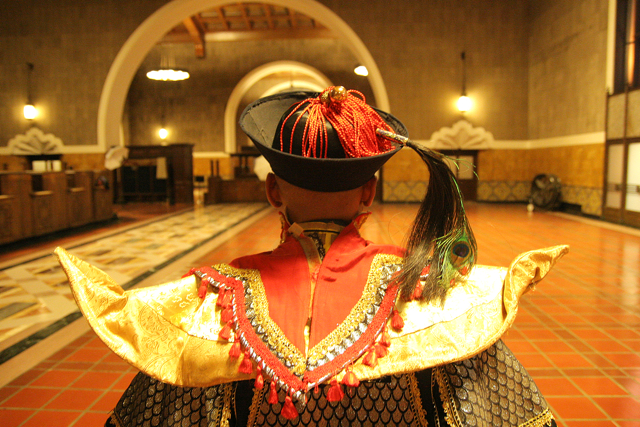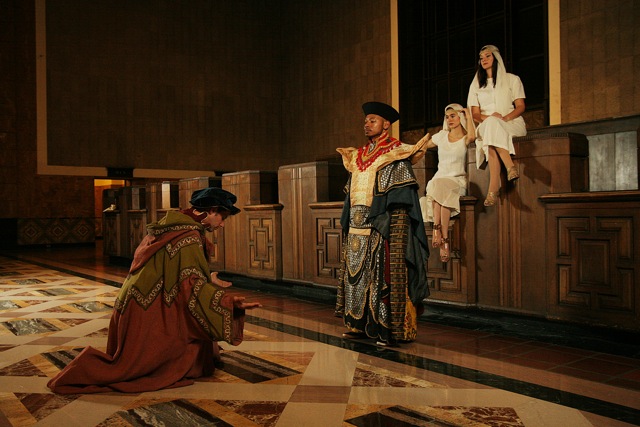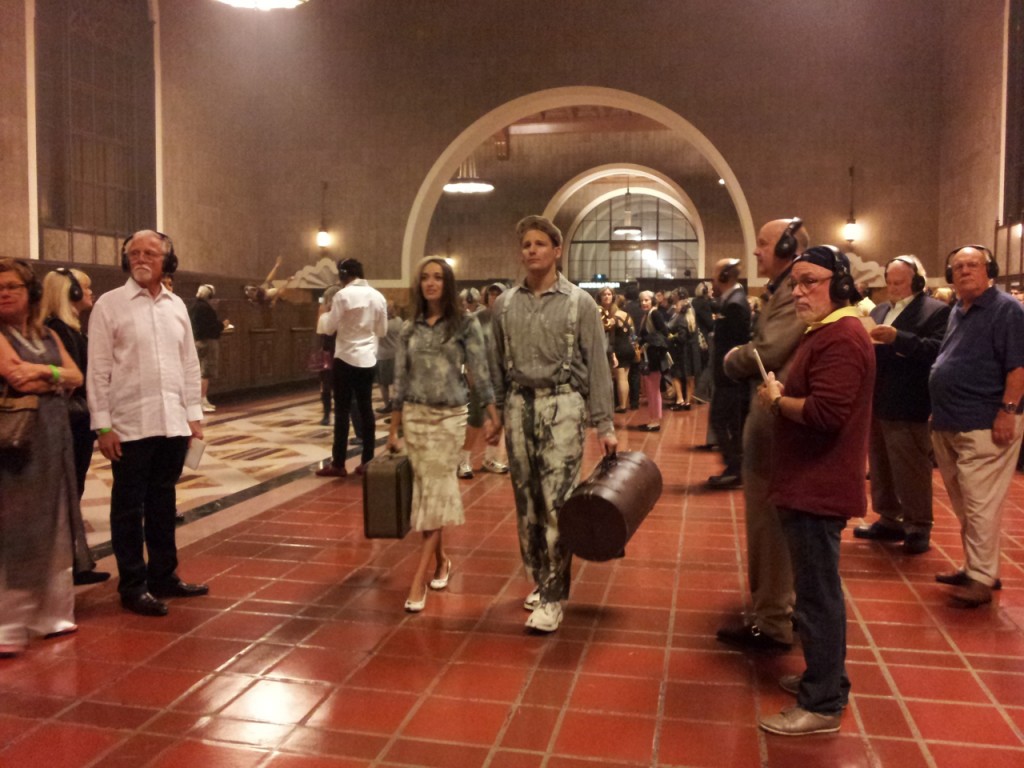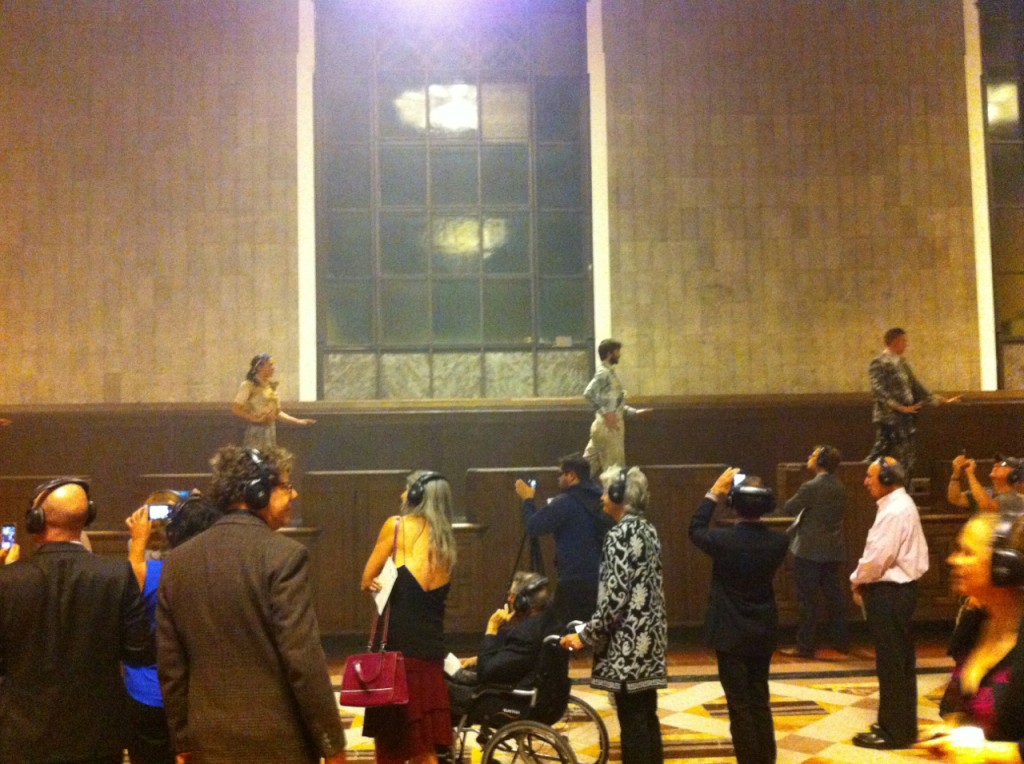The Real and Imaginary in Collision: Christopher Cerrone’s ‘Invisible Cities’ in LA’s Union Station
Review by David Gregson — Tuesday, October 21
Invisible Cities for all info.
In my recent commentary about Einstein on the Beach, I discussed the increased emphasis that postmodern artists place on the subjective response in the arts. For something as ephemeral and insignificant as my Opera West critique, it’s a complex matter impossible for me to discuss adequately without this review becoming unreadable. So, to put the matter as simply as possible, the creator of a work of art — be it a short story, a poem, a painting, a string quartet or an opera — expects an audience of distinct individuals, each of whom enters into the work of art on his or her own terms, and who emerges from the experience with a totally unique understanding and sense of appreciation. Has anything been communicated? It’s by no means certain. There is a sender and receiver, but the content of the message is ambiguous. Mutual and/or communal aesthetic and emotional sharing may have occurred, or possibly not. Bizet’s Carmen and Glass’s Einstein differ radically from one another in that Bizet uses a traditional musical-dramatic language intended to affect virtually everyone in the same way; but Glass is not concerned with such matters. You are invited to make of it what you will.
Composer Christopher Cerrone and his confederates have taken this idea to its logical extreme. Cerrone’s Invisible Cities, based on a genuine postmodern literary masterpiece, Italo Calvino’s so-called novel of the same name, is performed by singers, actors and dancers who move about a large public space — LA’s magnificent Union Station — and the audience and performers and honest-to-God real people get all mixed up together. No single experience, therefore, is duplicated by any other, and nobody (not even the producers themselves, one assumes) can grasp the entire picture. The people who have paid for this experience wear state-of-the-art audio Sennheiser headsets on which they hear a live orchestra and live singers; the train station patrons and homeless people wonder what the hell is going on; and the performers communicate tenuously via earbud headsets of their own. Needless to say, the producers are more coordinated than anyone else, but it’s doubtful they know fully what their colleagues are doing at all times.
The initial creative spark for this must be attributed to Calvino’s gorgeous “novel” — a collection of 55 highly evocative and fantastic poetic descriptions of cities that exist only in the mind. And yet these are all somehow real places, every one of them very similar to places we know or that we would like to know or that we think we know, and all of them have a bit of Venice in them. Underneath all of the poems lies a threat of decay and destruction, like the icy caves that undermine Xanadu in Coleridge’s famous poem, “Kubla Khan.” Calvino apparently borrows this famous Asian monarch and frames the novel as a conversation between Kublai (sic) and Marco Polo — and the whole book very well might be a delicious subject for philosophical speculation if I were not just now writing an opera blog instead. Let me just say that for me personally, Calvino’s words resonate deeply and conjure up a lifetime of travels, both real and imaginary.
Cerrone, with whom I met and chatted very briefly before the performance, is a gifted young Brooklyn based composer with a knack for setting texts in a beguiling lyrical manner. For a short time, readers have the opportunity to sample cuts of Invisible Cities online. I offer the link here. The work he has created could very well stand on its own as a sort of song cycle, and probably should be expanded to twice its current length. As it stands, there is an overture and only seven scenes. In the prologue, we hear Kublai Khan and Marco Polo entertaining the notion of the Chinese empire’s decay; and in the epilogue the conclusion is reached that “It is all useless, if the last landing place can only be the infernal city.” (The English translations of the Italian are by William Weaver, the 1974 Harcourt edition.) In between, however, Cerrone takes us to only three locations: Isidora of the encrusted seashells and feminine temptations; Armilla, the amusing town that is nothing but plumbing without walls; and Adelma, a place where all the faces we meet are the faces of our dead acquaintances. Midway though the piece, Marco Polo reveals the idea that the city of Venice underlies everything he has been speaking about. I feel Cerrone could enrich his piece by including a few more of Calvino’s cities. The three he has chosen do not seem to be quite enough.
My peripatetic experience began with getting a paper wristband and a set of large, padded Sennheiser earphones. I then joined an large assembly of guests in a particular wing of Union Station I do not recall having seen before from the inside. In any case, it is just off the right somewhere after one enters the building near the information booth. It was in this beautiful room that the orchestra was stationed and remained throughout the next 70 minutes. The ensemble consisted of violin, viola, cello, clarinet, flute, horn, trombone, harp, two pianos and percussion. Putting on and removing my headset while listening to these instruments live, I virtually could not tell the difference between the living and piped-in audio. Unfortunately, my headset was plagued by static, and nothing I did with the tuning dial seemed to change this. It simply got worse all evening. At one point I took the suggestion of pursuing someone in a red shirt who was supposed to help me tune the apparatus. Alas, I never got rid of the static — and all the while I was aware of how excellent the sound reproduction was. Potentially it was perfect. It seems unfortunate that the unlucky Sennheiser people should give a defective headset to someone writing about the opera on the internet. I met one other gentleman with the same problem, but my companion for the evening had no complaints. Sennheisser headsets, by the way, have been my earphones of choice for as long as I can recall. I have owned several pairs dating back to the early years of high fidelity recorded sound in the 1950s.
After the overture, I went wandering here and there, all over the station, inside the halls and outside in the patio-like gardens. Some of the people I encountered were wonderful dancers from the Los Angeles Dance Project, Benjamin Millepied’s creative collective. They might be pretending to be real travelers or workers in the station, or they might be aerobically in motion, individually or in sync with their colleagues. From time to time — I think, for to be frank it was all very hallucinatory and confusing — I ran into Marco Polo (Ashley Faatoalia) and even Kublai Khan (Cedric Berry), not to mention an assortment of singers and two women, Delaram Kamareh and Ashley Knight, who were dressed in white flowing garments and bearing fruit. I have listed the fine ensemble of singers below. So many people were involved in this, all I can do is offer the reader a gigantic list and say — well, here are the ones that should receive credit. Director Yuval Sharon, conductor Marc Lowenstein, and choreographer Danielle Agami and costumer E.B. Brooks for starters. The lead sound designer is E. Martin Gimenez and projection designer is Jason H. Thompson. The latter must be responsible for the bits of Calvino texts that appeared high on the walls here and there.
I would love to make some sort of sensible critical commentary on the Cerrone score and the performers’ execution of it (I dearly hope for a recording!), but the event’s distraction level was higher than anything I have ever experienced in my life. Happy is the man or woman who can simply go to Invisible Cities and experience this happening, this postmodern flashmob, and not have to evaluate it. Any one critic is limited to merely chance encounters with various elements of the production. Perhaps the most difficult aspect of the evening for me was making decisions: do I go this way or that way? Should I follow this person or that one? Should I follow the composer? Should I go where Marc Swed is going? He’s covering this for the LA Times. Director Sharon does provide 26 suggestions in the program — too many to list — and I am happy to say I took them all without having actually read them!
About midway in this intriguing adventure, I simply succumbed to my hiker’s fatigue and had to sit down somewhere. My arthritis was killing me. Ah! From far away I spotted the Traxx Bar — and it was almost empty except for a couple drinking cocktails at a table in front. They both were wearing headsets and were smiling. But, were they real or were they actors? I made a beeline for the bartender. “I need a drink!” I told him. “A glass of chardonnay.” The chardonnay appeared forthwith and when I tried to pay — well, no thank you. The drink was part of the performance package. The bartender marked my paper wristband with a black grease pen. And I went and sat contentedly at an empty table, sipping my wine and enjoying the music.
Just as I was beginning to feel like the reprehensible music critic who leaves a concert before the end, I noticed a man next to me who was moving his mouth in perfect sync with the sounds on my headset. And then all sorts of people gradually began to swarm around me, like some nightmare sequence from a science fiction short story by Philip K. Dick, he of androids fame. I cannot recall clearly what happened next. I think I went with the flow. The man may or may not have been sitting in a wheelchair or wearing a backpack. It’s all a blur, and not because of the drink. I have an enormous capacity for chardonnay without becoming befuddled.
I recall my personal epilogue quite clearly because I just happened to pass the large wing of Union Station apparently known as the “old ticket booth” room. It was empty except for what appeared to be a guard standing next to a men’s room sign at the far end of the hall. The space was slowly filling with smelly stage smoke. The men’s room appeared to be functional and I thought it would be just lovely to add that small venue to my utterly memorable Invisible Cities odyssey. Perhaps people were dancing in there too. So I entered and exited this mundane space with Cerrone’s lovely score filling my ears, and — heavens — when I re-emerged, the show and the mob were still after me! This time there were travelers, maidens, dancers on top of the ticket booths, cameramen, and even a fully functioning figure of Kublai Kahn in full monarchal regalia.
The absolute end came with public applause and a dreary speech by a no-doubt worthy local councilman. There were other luminaries as well. The performance had all been wonderful, but I was in no mood to hear a politico after two weeks of Ted Cruzifiction, so I turned the headset in and sped off to a wonderful downtown restaurant with my charming companion.
Wouldn’t you know it? The councilman and his party followed me (presumably not on purpose) into the same downtown restaurant, where the chef lavished him with attention whilst ignoring me and the other customers in the room. Was this still part of the show?
So came the end of my journey. Performances have been added, it seems, for those who want to set off from Union Station into an intriguing world where the real and imaginary either collide or fuse. You will be the judge.
By David Gregson
From the press release:
The Industry, L.A. Dance Project and Sennheiser Unveil
World Premiere of First-of-its-Kind Opera at LA’s Historic Union Station
LOS ANGELES (September 16, 2013) – The Industry, LA’s home for new and experimental opera, in partnership with the L.A. Dance Project and powered by Sennheiser, is proud to announce that tickets are now on sale at www.InvisibleCitiesOpera.com/tickets for Invisible Cities, an innovative production representing a thrilling new collaboration of art and technology that has never before been done. Invisible Cities makes its world premiere on Saturday, October 19 for a limited run through November 8. Because the live performance will be experienced via premium wireless headphones from Sennheiser in the spectacular setting of Los Angeles’ iconic Union Station, while the station is still operating, space will be limited. The use of headphones will make this performance a highly personal experience in a highly public space allowing the audience to act as a participant roaming freely through the station, following individual characters or creating their own adventure in the moment.
Performance dates for Invisible Cities are Oct. 19, Oct. 24, Oct. 26, Oct. 29, Oct. 31, Nov. 5, and Nov. 8. There will be two performances each night except for October 19. The VIP experience includes exclusive access to a roped off area of the Harvey Restaurant and a glass of wine.
7:30pm performances: $60, $75 VIP
10:00pm performances: $45, $60 VIP
“$25 Tuesdays” — All headphones for the 10:00pm shows on Tuesdays are $25
“The opera will function as an invisible layer of everyday life, and every audience member will have a different, radically subjective experience of the opera,” said Yuval Sharon, director of Invisible Cities and artistic director of The Industry. “It’s an ideal way to bring Calvino’s masterpiece to life and to hear Chris’s quiet, haunting original score—all while celebrating a landmark of L.A.’s architecture.”
Composed and adapted by Christopher Cerrone (hailed as “a rising star” by the New Yorker), this fragile, quiet score attempts to capture “decaying sounds” through the use of found objects as instruments and pre-recorded voices interweaving with live voices. The instrumental music will be a mixture of pre-recorded and live performances from an eleven person orchestra.
During the course of the performance, all vocalists will sing live as they freely move throughout Union Station, appearing and disappearing into the everyday fabric of the building. Dancers from the L.A. Dance Project, the company founded by artistic director and choreographer director Benjamin Millepied, are featured in a site-specific new choreography by the LA-based Danielle Agami.
“L.A. Dance Project is incredibly excited to partner with The Industry for what promises to be a unique performance experience,” said Millepied. “The kind of bold artistic adventure that makes L.A. so special.”
The involvement of Sennheiser, a leader in sound and wireless transmission technology ensures that Invisible Cities will offer the highest possible sound reproduction without distortion, delay and interference. Due to the technological demands of this production, this type of performance would not have been possible even ten years ago.
Music and libretto by CHRISTOPHER CERRONE
Based on the novel by ITALO CALVINO
Director: YUVAL SHARON
Conductor: MARC LOWENSTEIN
Choreographer: DANIELLE AGAMI
Lead Sound Designer: E. MARTIN GIMENEZ
Costume Designer: E.B. BROOKS
Projection Design: JASON H. THOMPSON
Properties Designer: SARAH KRAININ
CAST
Kublai Khan CEDRIC BERRY
Marco Polo ASHLEY FAATOALIA
Woman 1 DELARAM KAMAREH
Woman 2 ASHLEY KNIGHT
Soprano MARIA ELENA ALTANY
Alto SARAH BEATY
Tenor STEPHEN ANASTASIA
Bass CALE OLSON
LA DANCE PROJECT COMPANY
BENJAMIN MILLEPIED, Founding Director
DANCERS:
CHARLIE ALLAN HODGES
ANTHONY BRYANT
AARON CARR
JULIA MARION EICHTEN
MORGAN TAYLOR LUGO
NATHAN B. MAKOLANDRA
RACHELLE ANN RAFAILEDES
AMANDA KRAMER WELLS
ORCHESTRA
Trombone MATT BARBIER
Violin ERIC KM CLARK
Viola BETH ELLIOTT
Percussion JODIE LANDAU
Piano 2 CLARE LONGENDYKE
Harp JILLIAN RISIGARI-GAI
Cello DEREK STEIN
Piano 1 / Rehearsal Pianist RICHARD VALITUTTO
Clarinet BRIAN WALSH
Flute SARAH WASS
Horn JACOB WILDER
PRODUCTION TEAM
The Industry General Manager DAVID MACK
Associate General Manager RACHEL SCALDING
LA Dance Project Producing Director CHARLES FABIUS
LA Dance Project Company Manager KATHRYN LUCK STONE
Production Manager RICK CULBERTSON
Assistant Director / Production Stage Manager JEAN LEE
Rehearsal Stage Manager CHAD PARKER
Associate Sound Designer RYAN AINSWORTH
Lighting Consultant ELIZABETH HARPER
Assistant Conductor ANDREAS LEVISIANOS
Sound Engineer JACKSON CAMPBELL
Assistant Sound Designer KIMBERLY EGAN
Assistant Sound Technician VERONICA MULLINS, DYLAN SHYKA
Assistant Costume Design KATE FRY
Wardrobe Supervisor CINDY SAKUMOTO
Assistant Stage Manager RITA SANTOS
Marketing & Outreach Coordinator MITCHELL COLLEY
Directing Interns JENN DEES




